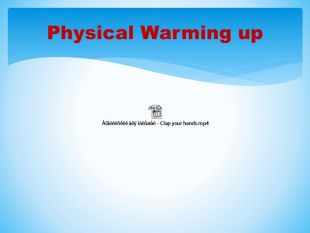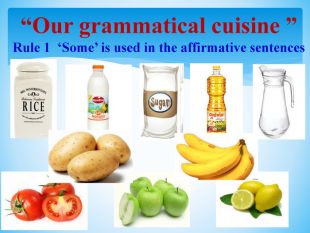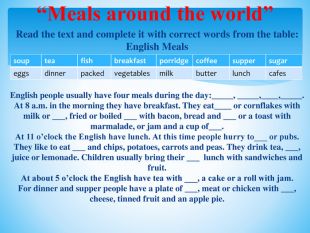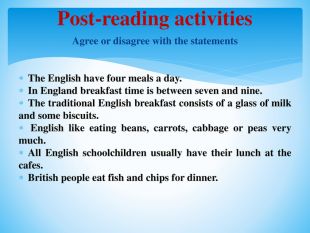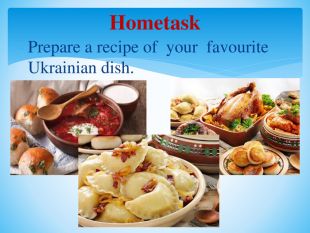Урок за темою "Eating Habits"
Розробка уроку містить цікаві інтерактивні вправи для розвитку комунікативних навичок учнів 5 класу, на допомогу вчителеві розроблена презентація даного уроку і приклад дитячого проекту.
- урок у 5 класі docx
- Eating Habits pptx
- My Meals pptx
![]()
![]()
![]()
![]()
Eating Habits
(open lesson in grade 5)

![]()
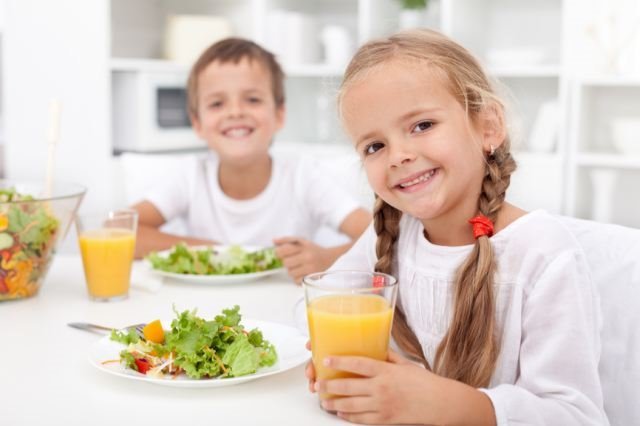
Theme: Eating Habits
Main aims:
- To revise and practice vocabulary on the basic of grammar material;
- to teach how to use the gained knowledge and information in speech and develop skills in listening, reading, speaking and writing;
-to cultivate a positive attitude towards a healthy lifestyle.
Materials: a laptop, worksheets, a blackboard, posters, presentations.
Procedure
I. Introduction
1. Greetings
T: Good morning, boys and girls, good morning, dear guests.
I’m glad to see you.
Ps: Good morning, teacher. Good morning, dear guests.
T: How are you?
Ps: We are fine, thank you.
T: What is the weather like?
Ps: The weather is cold. It is snowy and windy. The sky is cloudy.
T: Children, today we have an unusual lesson. We’ll speak about your eating habits and train your skills in listening, reading, speaking and writing. You will present your own projects, guess different riddles, and work with a text. You must use new words and word-combinations in your speech. Now, let’s start.
- Phonetic drill
T: Our first task is to train sounds. (слайд 3) Listen to Julia, and repeat after her. Help us, please.
[˄] butter, mushroom, cut, lunch
[æ] cabbage, apple, sandwich, jam
[ı] fish, chips, biscuit, dinner
[e] bread, egg, lemon
[i:] tea, meat, beans, meal
[aı] rice, ice cream, pie
2. Warming- up
T: Ok. We have already warmed up our tongues, let’s warm up our brains. And our next task is to complete these sentences. Look at the slide of the presentation “What word can we add to the sentence?” (слайд 4)
Ex. I have breakfast, lunch and dinner and____ (supper)
T: Thank you. You are so good. Our next task is “Housekeeping encyclopedia”. Do you know that different products can be countable and uncountable?
Look and say, what kind of noun is it? (slide 5)
|
Countable nouns |
Uncountable nouns |
|
potatoes |
sugar |
|
carrots |
milk |
|
|
|
3.Main part
T: Children, I’ve prepared a very interesting film. Your task is to watch and listen it very carefully and be ready to do a test after that.
( slide 6)
T: Let’s control how you’ve understood this film?
(slide 7 and 8) .
1. What is the boy’s name?
a) Tom b) Nick c) John
2. How old is he?
a) fifteen b) twelve c) ten
3. Where does he live?
a) London b) Oxford c) Cambridge
4. What day is it?
a) Friday b) Saturday c) Wednesday
5. What time is it?
a) 8p.m. b) 7 a.m. c) 8 a.m.
6. What have children got ………. in their lunch boxes?
a) a packet of crisps, a carton of juice, an apple, a banana and a sandwich.
b) a packet of crisps, a carton of juice, a pear and a banana
c) a packet of crisps, a bottle of water, an apple, an orange and a sandwich
7. Where is Molly’s orange juice?
a) on the table b) in the fridge c) in the cupboard
8. When has the family got take-away food?
a) Friday b) Sunday c) Saturday
9. What food does Molly like?
a) Indian b) Chinese c) Italian
10. What is Nick’s favourite food?
a) Curry b) pizza c) fish and chips
11. Who comes to do shopping for dinner?
a) Mummy b) daddy c) children
T: Children, I‘ve asked you to prepare some projects about your eating habits.(slide 9)
P (1)
P (2)
(Children present their projects)
Physical Warming up
T: I think we have to relax a little. Let’s do some exercises (slide 10)
T: Thank you very much. It was so interesting. You are at school now. Some of you have lunch in the school canteen; others have got a packed lunch. This box is empty. What would you like to put into it? Look at these products and choose the most useful. ( slide 11)
Ex. I’d like to put an apple. Apples have many vitamins
As for me I usually eat__________
My mum usually puts___________
I don’t eat _______ because _______
Development of grammar skills.
T: Thank you. It’s time for our next task. Welcome to “Our grammatical cuisine ”. We’ll revise a grammar rule. Look at the screen. Here you see some pictures.
I have got a carrot and some sugar on the table. Can you count carrots?
Pupils: Yes, we can.
T.: Can you count sugar?
Pupils: No, we can’t.
T.: But sometimes I am lazy. I don’t like counting. What words can I use instead of quantity?
Pupils; some/ any
T.: You are right. Some or any. (slide 12) (slide 13)
‘Some’ is used in affirmative sentences and we can use ‘any’ in negative and interrogative sentences.
Let’s use word ‘some’ describing these pictures.
(pictures with different things)
Ex. There is some rice in the jar.
There are some apples on the table. (Ex. p. )
Now you see negative and interrogative sentences.
What word can we use?
Pupils: ‘any’
(work in pairs)
T.: That’s right. Children, now we’ll work in pairs. Look, it’s a fridge. It is magic and there is much different food there. Let’s ask what’s in it. Besides you have to use grammatical constructions ‘There is … or There are…’(slide 14)
(There is a picture of fridge on the screen)
Ex. -Is there any milk in the fridge?
-Yes, there are three bottles of milk in the fridge.
-Is there any cheese in the fridge?
-Yes, there is some cheese in the fridge.
T.: It is nice. Now, let’s do the exercise number__ on page__. Polly and Dan, I want to control your knowledge. You have to do the same exercise in the blackboard. Use ‘some’ or ‘any’ in the sentences.
Sasha, Vicky and Kirill, show me your copy-books. I hope you have already finished doing this exercise.
T.: Thank you, children. All these sentences are correct.
T: And now, it will be our next task. You have to read the text and complete it with necessary words. (slide 15)
|
soup |
tea |
fish |
breakfast |
porridge |
coffee |
supper |
sugar |
|
eggs |
dinner |
packed |
vegetables |
milk |
butter |
lunch |
cafes |
English Meals
English people usually have four meals during the day:_____, _____,____,_____.
At 8 o’clock in the morning they have breakfast. They eat____ or cornflakes with milk or ___, fried or boiled ___ with bacon, bread and ___ or a toast with marmalade, or jam and a cup of___.
At 11 o’clock the English have lunch. At this time people hurry to___ or pubs. They like to eat ___ and chips, potatoes, carrots and peas. They drink tea, ___, juice or lemonade. Children usually bring their ___ lunch with sandwiches and fruit.
At about 5 o’clock the English have tea with ___, a cake or a roll with jam.
For dinner and supper people have a plate of ___, meat or chicken with ___, cheese, tinned fruit and an apple pie.
T: Look at these sentences and say what is true or false.(slide 16)
• The English have four meals a day.
• In England breakfast time is between seven and nine.
• The traditional English breakfast consists of a glass of milk and some biscuits.
• English like eating beans, carrots, cabbage or peas very much.
• All English schoolchildren usually have their lunch at the cafes.
• British people eat fish and chips for dinner.
T: So, boys and girls how you liked it? It was nice, isn’t it? I hope you’ve understood everything. And now, let’s remember interesting food traditions in England which we’ve talked about in previous lessons. Use this knowledge to complete this task. Look at the screen and match two halves of the sentences. (slide 17)
|
1. At Easter people eat 2. The English like tea 3. Sunday lunch consists of 4. Shepherd’s pie 5. At Christmas 6. On Halloween children get |
a) hot cross buns b) with milk c) roast meat, vegetables and Yorkshire pudding d) consists of lamb mince and mashed potatoes e) people usually eat roast turkey f) candies, fruit, cakes and other tasty things |
III. Summing-up
1. Reflection
T: Today you’ve learned eating habits. Look at your desks. Everyone has got three candies – red, yellow and green one. If you took part in different activities and understood everything, put a candy into the green box. If you only helped sometimes and didn’t understand everything, put a candy into the yellow box. If you didn’t understand and didn’t remember anything, use a red one.
Ps:
Ex.-I put my candy into the green box. I have understood everything.
-I understood something, but some words are difficult for me…..
2. Home work
Children, your task will be to do exercise_____ on page____. Write the ingredients of your favorite dishes.
3. Evaluation
T: At the end of our lesson, I have to evaluate your knowledge. Thank you for the good preparation for the lesson. Many students showed their perfect skills in oral speech, reading, and writing. Your mark is 12. ____ admitted some mistakes in the pronunciation of words and the execution of a written exercise. I’m pleased with the work of____________ . I recommend you to prepare more carefully for the next lessons.
I’m satisfied with these results of work. And I wish you to be more attentive and more active at the lesson.
Thank you. Try to be inquisitive and improve your English.
Good-bye. See soon.


про публікацію авторської розробки
Додати розробку
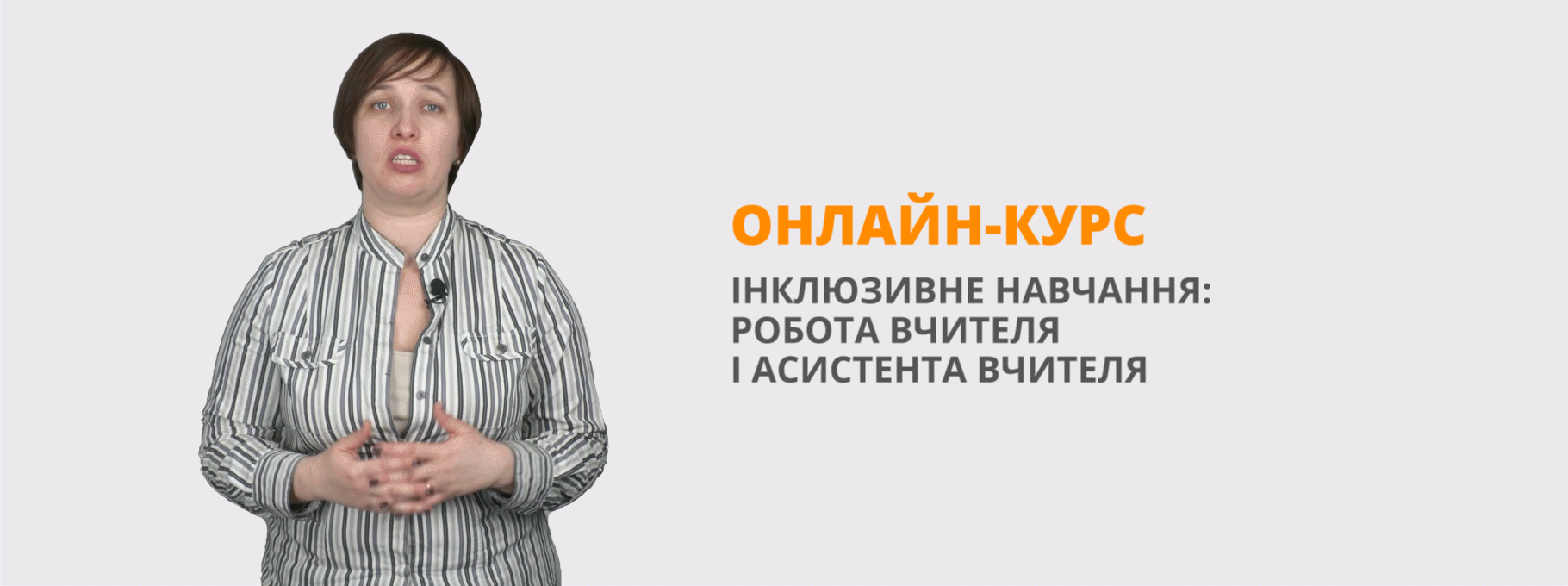


![[˄] butter, mushroom, curry[æ] cabbage, apple, sandwich, jam[I] fish, chips, biscuit[e] bread, egg, lemon[i:] tea, meat, beans, meal[ai] rice, ice cream, pie“Phonetic drill for breakfast” [˄] butter, mushroom, curry[æ] cabbage, apple, sandwich, jam[I] fish, chips, biscuit[e] bread, egg, lemon[i:] tea, meat, beans, meal[ai] rice, ice cream, pie“Phonetic drill for breakfast”](/uploads/files/18884/23519/23644_images/3.jpg)























